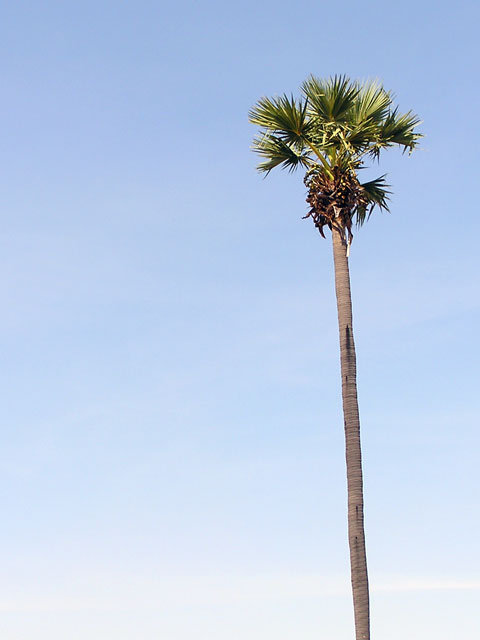The ubiquitous feature of the Cambodian rice paddy landscape are the sugar palms which punctuate the flat landscape, skinny fists of fronds lifted in the air like antennas to heaven. They’re a versatile plant providing fruit (palm hearts and pulp from the husk), fresh sap (which can be taken straight, fermented into vinegar or wine, or cooked into palm sugar), and leaves that are woven into mats and roofing.
Vuth buys his palm sap daily from across the river and catches the ferry into Phnom Penh to vend the sap and a few blocks of palm sugar door-to-door. It is a marginal lifestyle : for his day of cycling he makes a profit of one to two dollars from the sap and a little more if he sells some sugar. He says his palm juice is the sweetest in Phnom Penh and it certainly is fresh. The naturally occurring yeasts that collect in palm sap begin fermenting the fluid within a few hours of extraction, resulting in a tart and sulphurous brew. Vuth’s had not begun to take on that unpleasant alcoholic note and was the sweetest I’ve had.


the thing that is of persistent fascination to me when you look out across a seemingly endless vista of rice fields and palm trees is that each and every tree jutting out over the vast expanse of countryside is owned and accounted for…
I know it perhaps seems a trivial observation to most but the signifance of the humble palm tree dawned on me when I first arrived in Cambodia and there was drought conditions over much of the country. As a result farmers had taken to cutting down the trees to sell the timber, meaning they were cutting what is essentially a cash cow, meaning that each palm tree is a form of stored wealth and also a significant signal of the health of the agricultural sector
I remember seeing a campaign somewhere to try to get people to stop chopping down the palms for charcoal/timber during the drought. Obviously not hugely successful.